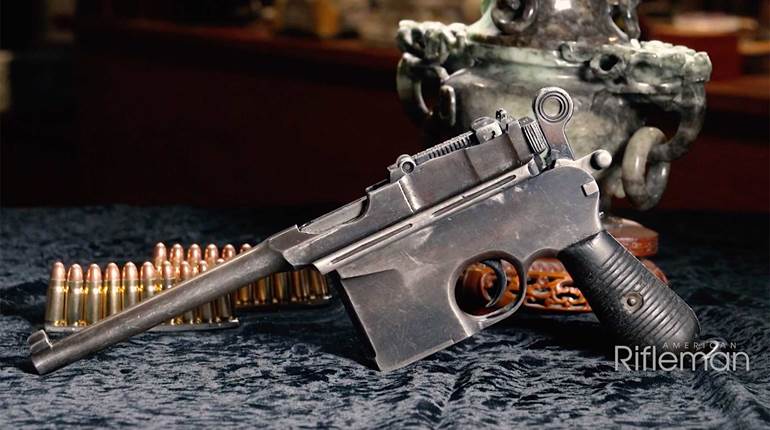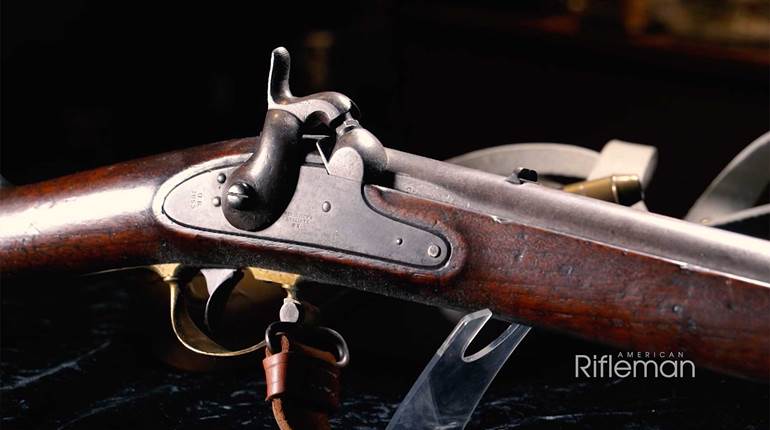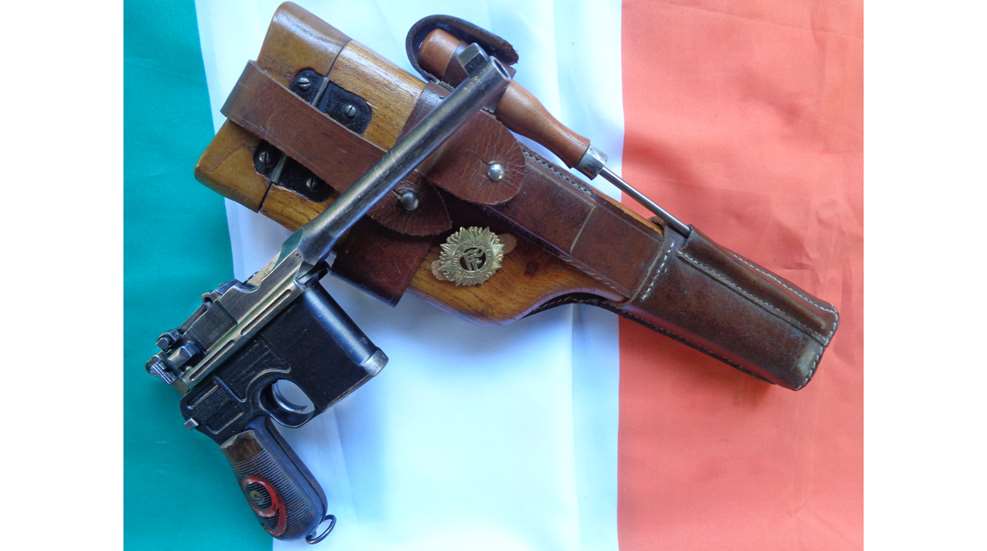
While caring for his ailing sister in Dublin during the 1970s, Major Richard J. (“Dick”) Keogh, a retired U.S. Army ordnance officer, found that he had time on his hands. The Keogh family had immigrated to New England from Ireland in the early 20th century, but his sister had returned to Ireland and had undergone surgery. The family contained a number of relatives who had been notable personalities during the “Troubles” of 1916-1923, so Dick grew up hearing tales of those times. Dick joined the U.S. Army after World War II and had served with distinction during the Vietnam War, eventually retiring in Honolulu. While taking care of his sibling in Dublin during her recuperation from surgery, he visited the museum at Kilmainham Gaol, and, having an extensive background in small arms, offered his expertise to the museum’s staff in re-cataloging their arms collection.
During his work in Kilmainham’s collection (about which he later wrote an article for Arms Gazette), he found very few books or articles that specifically detailed the various firearms used in the “Irish Revolution” of 1913-1923, although there was information about their use in other published histories. Realizing there was a need for this information, Dick used those accounts to publish an article about Irish Lugers in March 1979 for Arms Gazette, as well as other articles about the guns carried by the noted Irish revolutionaries, like the Countess Markievicz and Padriac Pearse, during Dublin’s “Easter Rising” in 1916. Dick also drafted an article about the Mauser “Broomhandle” pistol in Ireland (usually known there as “Peter the Painter”) but it was never published. Here is what Dick had to say in 1980:
"The Mauser Model 1896 pistol has been used all over the world. In the United States, it has acquired the nickname “Broomhandle.” It may surprise you to know that in other countries the familiar Broomhandle is called by an entirely different name. This is the story of Mauser usage in the Irish War of Independence, from 1916 to 1921. This independence struggle was a guerrilla war fought in the shadows. The historians and commentators who wrote about it focus their efforts on the cultural, social, and political aspects of the struggle. Very few knew anything about firearms, so it is difficult to reconstruct what arms were actually used.
Literary inaccuracy is compounded by the fact that the Model 1896 Mauser was called a “Peter the Painter”, or simply a “Painter”, or even “Peter Painter.” This nickname refers to a notorious European anarchist who was involved in several shootouts in London in 1911. He was accused of killing policemen with a C 96 Mauser, and, when he was cornered in a house in the east end of London, he shot it out with a battalion of Scots Guards. Eventually, the house was set on fire and Peter the Painter and two confederates supposedly were burned to death. Any good biography of Sir Winston Churchill will give you all the details on the “Siege of Sidney Street.” Suffice to say that Peter the Painter took up arms against the British Crown. This made him famous among the Irish patriots, and they applied his name to the type of pistol he used.
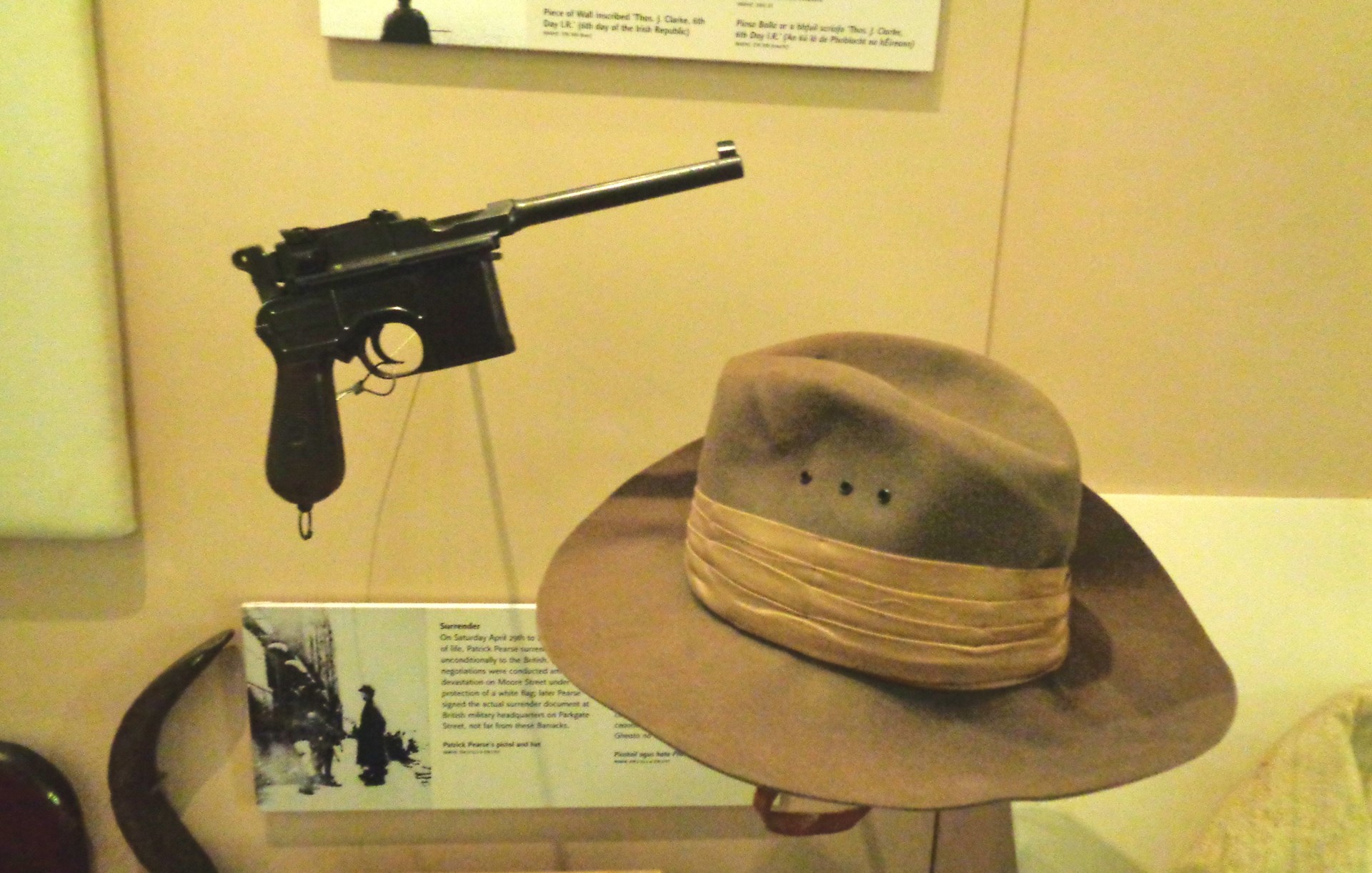 The “Soldiers and Chiefs” gallery in the National Museum of Ireland has a number of significant “Peter the Painters” on exhibit, including ones from the 1916 Easter Rising (as seen here), as well as from the War of Independence, and the Irish Civil War. Image courtesy of authors.
The “Soldiers and Chiefs” gallery in the National Museum of Ireland has a number of significant “Peter the Painters” on exhibit, including ones from the 1916 Easter Rising (as seen here), as well as from the War of Independence, and the Irish Civil War. Image courtesy of authors.
The Mauser 1896 pistol was designed for use either as a pistol, or as a carbine. This made it particularly useful in a guerrilla war. While we do not know exactly how many Mausers saw service in the 1916 to 1921, we do know about how many were on hand when the Truce of July 1921 ended the fighting. Guerilla armies do not keep good property records when an occupying army vacates a newly independent nation. Most of the records either go with the departing troops or are destroyed, so there will be, of necessity, gaps in the story.
The Irish Volunteers, formed in 1913, used any available arms. Photos of this period show arms of all sizes and types. In 1914, the Irish Volunteers received a shipment of about 1,500 Mauser Model 1871 rifles. This was the only large shipment of arms, all of the same type or model, ever received by the Irish Volunteers or the Irish Republican Army. Any stories you have heard of arms shipments by submarine are just not true. Every record of the 1916-1921 Period, both official and personal, agrees that Mauser pistols were acquired mostly one by one. Initially, they were stolen from the homes and castles of the British overlords. Eventually, the clandestine supply system was able to smuggle them in from Europe in small numbers.
And, indeed, we're talking about a small number of Mauser pistols in the struggle. During the 1916 Rising, which lasted only six days, only two Mausers were mentioned. One of these still exists and is on display in the National Museum of Ireland. Perhaps the most famous of all the Irish Broomhandles, it belonged to Countess Constance Markievicz. Her story was told in detail in 1979 in another magazine. (*Note—Dick published articles about her handguns and the pistol of the uprising’s leader, Padraic Pearse, in 1979.) Her Mauser is a standard prewar commercial model, serial number 162742, and the holster shoulder stock with this pistol carries the serial number 692. The Countess was a member of the wealthy landed aristocracy, and she probably bought her Mauser before 1913 in Europe, as it shows no British proof marks.
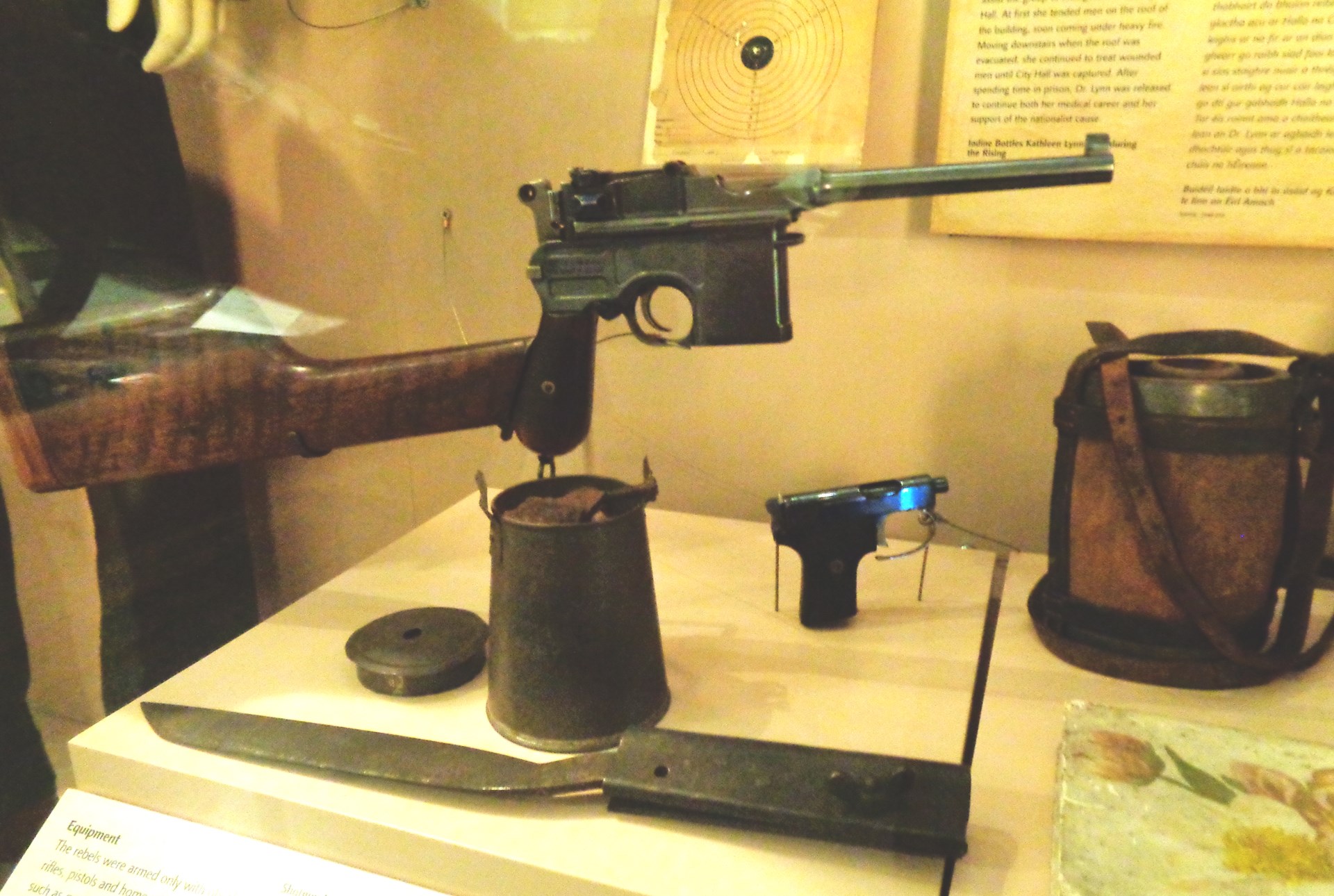
For many years, Countess Markievicz’s iconic pistol was on display at the National Museum of Ireland on Kildare Street in Dublin. It is now on exhibit in the “Soldiers and Chiefs” gallery of the new National Museum’s branch at Collins Barracks, on the other side of the Liffey River. Image courtesy of authors.
Both British and Irish accounts of the Easter Rising agree the Countess Markiewicz used her Mauser to shoot at British troops in the fighting around St. Stephen's Green. The British confirmed her valor, vigor, and importance to the Nationalist cause. They sentenced her to death. This sentence was commuted to life imprisonment, and she was, in fact, released after only 13 months in various British jails-- but she never got her Mauser back.
The only other Mauser mentioned in any accounts of the Easter Rising is one Joseph Plunkett carried. He was one of the leaders of the Irish Republican Brotherhood that had planned the Rising. Son of a prominent family, Plunkett was a poet who had made a secret trip to Germany before the Rising. We can assume that his Mauser was acquired there. Plunkett served in the General Post Office, the headquarters of the Nationalist forces during the Rising. This building, and of all those surrounding it, were set on fire by British artillery. Plunkett either lost his Mauser in the evacuation of the burning building, or it was taken by one of the British soldiers who stripped and searched him after his surrender. In any event the location of this Mauser is unknown today, Plunkett was shot by firing squad on 4 May 1916, just five days after the surrender of the Nationalist forces. (*Note—Dick did not mention two other notable instances in which Mauser C96s were used during the Easter Rising—Lt Michael Malone on Northumberland Road, and Cathal Brugha’s last stand in the South Dublin Union. See “Guns of the Easter Rising” American Rifleman, Sep 2013.)
May 1916 until January 1919 there was a lot of political activity in Ireland, but no military actions. The period from January 1919 to July 1921 is known variously as the “War of Independence”, the “Anglo-Irish War”, or the “Black and Tan War.” The Mauser Broomhandle, or “Peter the Painter” was widely used by the Nationalist forces in this period. There is in existence an inventory report to the Chief of Staff of the Irish Republican Army, dated 1 September 1921. (*Note—Dick Keogh copied this report by hand in pencil while researching at the National Library of Ireland.) This report lists all of the arms on hand and it is on a set of printed forms. It took time to collect all the data from all over the country, have the forms printed, and to collate the data. This report should give a fairly accurate picture of the arms situation at the time of the truce on 11 July 1921. So, we know fairly accurately how many Painters the Nationalists had on hand at the end of the war.
There were 160 Peter the Painter pistols on hand, out of a total of 1,147 handguns of all types. These 160 pistols were spread out among 19 units, from one end of Ireland to the other. The largest numbers were found where the fighting was heaviest. The first Southern Division in Cork and Kerry had 36; the Second Southern Division in Tipperary had 29. The next largest number is the 20 Painters in the hands of the Dublin brigade. Many divisions and brigades had only one or two.
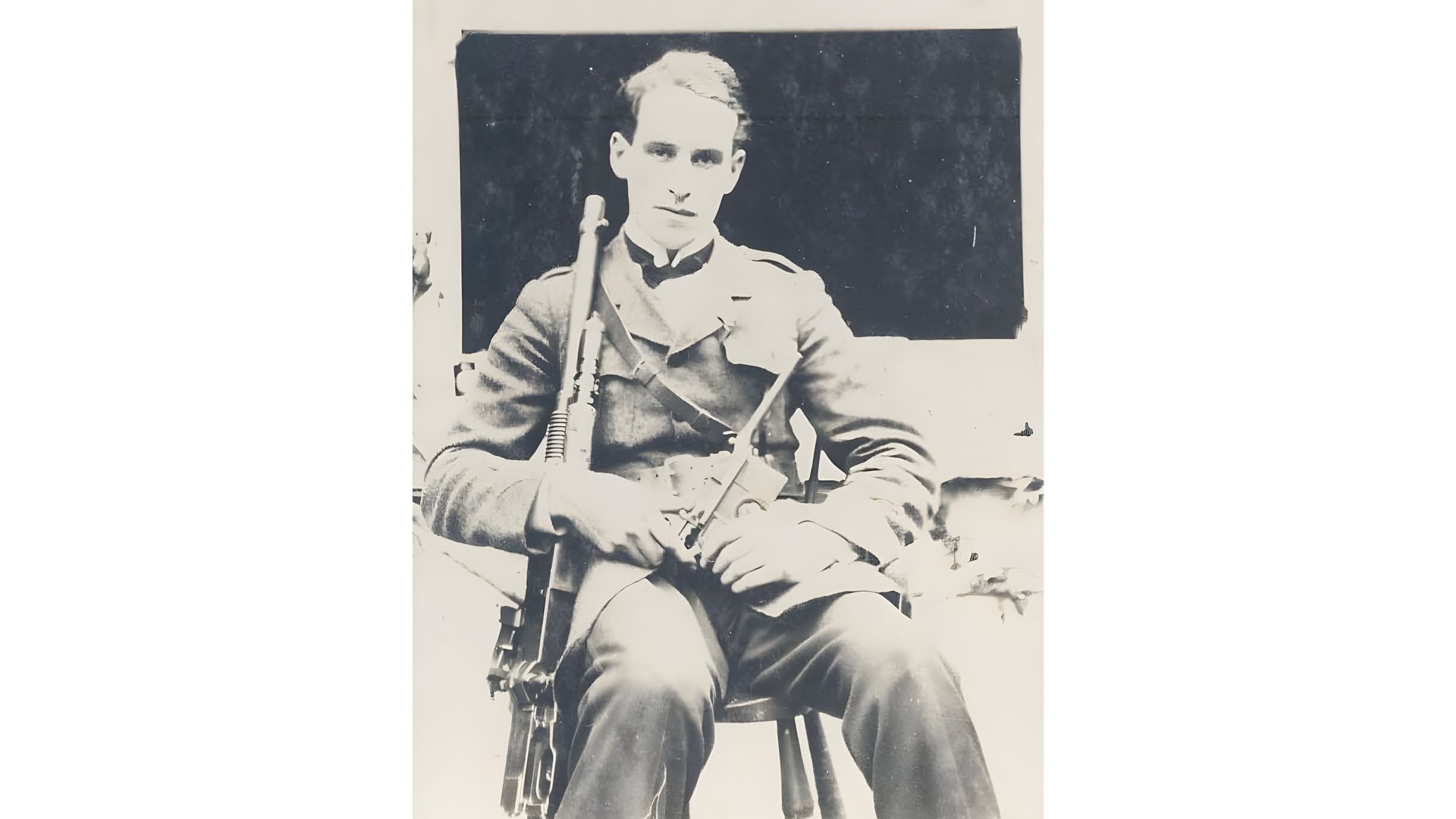 This Irish Volunteer not only holds a C96 Mauser, but he is also posing with a captured British “Hotchkiss Portative” .303 light machine gun. Although concentrated in the areas that saw the most fighting, “Painters” could be found in IRA units across Ireland. Image courtesy of Michael Curran.
This Irish Volunteer not only holds a C96 Mauser, but he is also posing with a captured British “Hotchkiss Portative” .303 light machine gun. Although concentrated in the areas that saw the most fighting, “Painters” could be found in IRA units across Ireland. Image courtesy of Michael Curran.
One of the most aggressive fighters in the first Southern Division was Tom Barry. He led the West Cork Flying Column, whose account of those actions is a veritable textbook on how to fight a guerrilla war. Fifty years later, the Vietcong were using the same tactics with great success. Tom Barry carried and used the Painter in many of these actions. The Cork City Museum has on display a photo of Barry holding his Painter. He carried this pistol at the battle of Crossbarry on 19 March 1921. He said later it was “faster, and as accurate, as any rifle, up to 300 yards.” In this action, the Flying Column of 104 officers in men fought its way through an encircling British force of about 1,200 troops. The Barry Mauser was also a standard prewar commercial model. The serial number is unknown and it disappeared from Cork some years ago. It may be now in the hands of some Nationalist in Northern Ireland.
The Kilmainham Gaol Museum in Dublin has on display the Mauser Broomhandle of Captain M. Murray of the Dublin brigade. This pistol was used when the Dublin Brigade attacked, seized, and burned the Customs House in Dublin on 25 May 1921. This building was the center of the entire British civil administration in Ireland. The building, with its files, records, and reports burned for almost a week. The Dublin Brigade had heavy losses in this action. Eighty of 120 men involved were captured, and five were killed. Captain Murray lost his Mauser in the round up after British troops and police surrounded the area. This Model 1916 Mauser is in 9 mm Parabellum, serial number 93685, with its shoulder stock number 272.
The use of Painters in Dublin was sound. The high rate of fire, and compact size, made it an ideal weapon for urban guerrilla warfare. A Painter played a significant part in the daring attempt to rescue Sean MacEoin from Mountjoy Prison in Dublin on 14 May 1921. A British armored car was captured, and used to gain entry into the jail yard. Forged papers were presented to “spring” MacEoin. At the last moment, questions were raised, the plan collapsed, and the rescuers were forced to shoot their way out of the jail. A British sentry in a key position on the jail roof was shot from his perch by a burst from a Painter. Republicans made good their escape in the captured armored car, which was later stripped and burned.
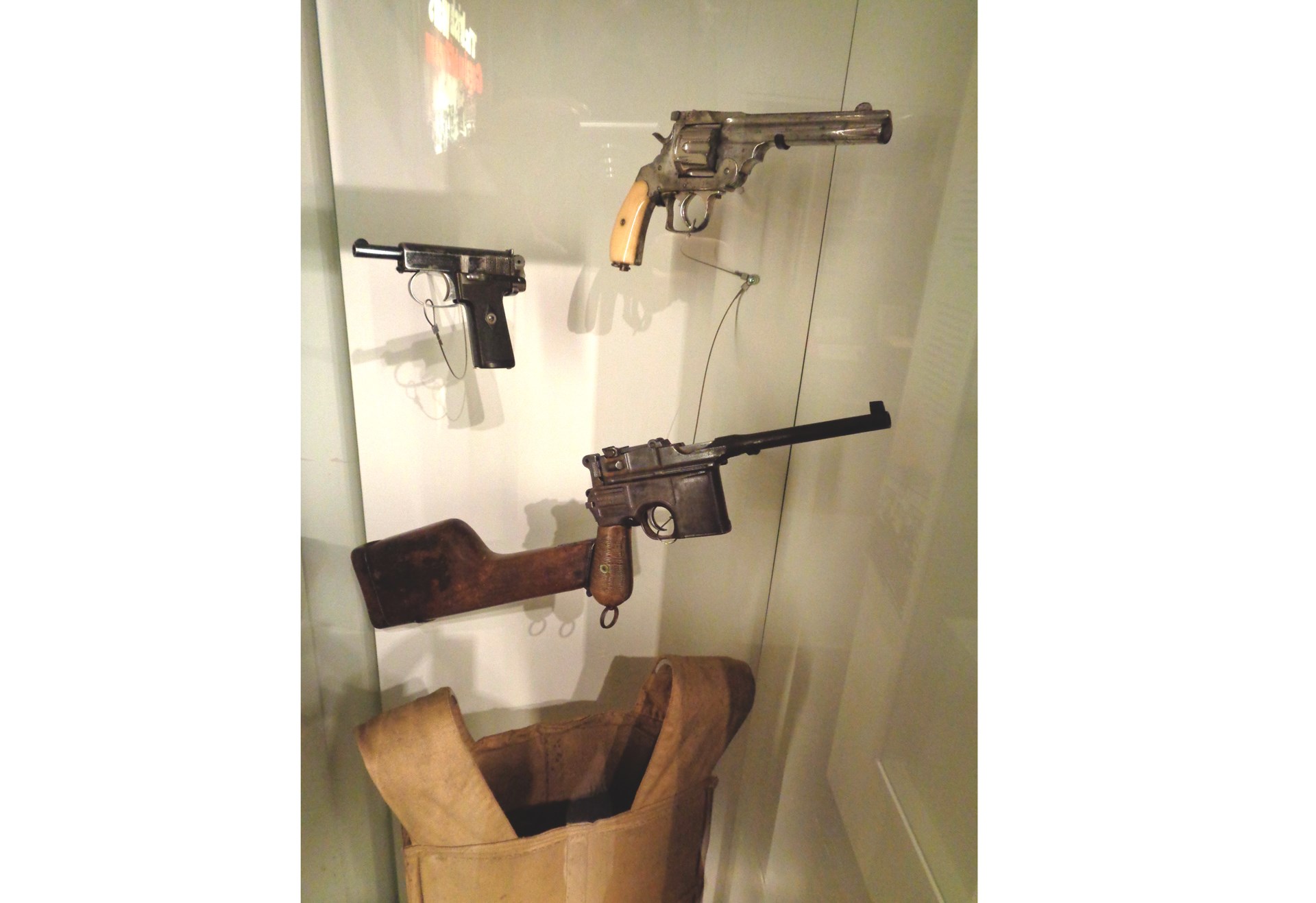 Through family connections, Dick Keogh was able to interview a number of significant characters of the 1916-1923 while he was in Ireland during the late 1970s and early 1980s. One of them was Commandant Vincent (“Vinny”) Byrne, who carried a Mauser like this (seen here on display in the National Museum of Ireland) while serving on Michael Collins’ “Squad.” Image courtesy of authors.
Through family connections, Dick Keogh was able to interview a number of significant characters of the 1916-1923 while he was in Ireland during the late 1970s and early 1980s. One of them was Commandant Vincent (“Vinny”) Byrne, who carried a Mauser like this (seen here on display in the National Museum of Ireland) while serving on Michael Collins’ “Squad.” Image courtesy of authors.
Commandant Vincent Byrne is one of the few survivors of Michael Collins’ “Squad.” This elite unit of Irish Volunteers had as its sole mission the elimination of British army intelligence officers, police spies, and political detectives. Commandant Byrne, who was a teenager at the time, carried both a 9mm Painter and a short .455 Webley revolver. He used his Mauser in many actions against the British intelligence apparatus. He participated in Bloody Sunday. In this action, 14 British intelligence officers were simultaneously executed in various parts of Dublin on the morning of 21 November 1921. Byrne was also present at the burning of the Dublin Customs House, and escaped with both of his pistols. He turned in his Mauser when he left the Irish Free State army in 1929. In a 1980 interview, he told me the Painters and Parabellums (Lugers) were both very popular weapons among members of ”The Squad.”
These are all small actions in a small war— but they are important. They not only add another chapter to our knowledge of the history and use of the Mauser model 1896 pistol, but we can find a larger lesson here as well. This was the first successful war of national liberation against the British Empire since George Washington led our own nation to victory in 1781. Since 1921, there have been many wars of national liberation in all parts of the world. Insurgency and guerrilla warfare are more common today than is formal combat between conventional military forces.
In recent years, about 1960, to be exact, an unusual Mauser was surrendered to the Irish Defense Force. This pistol fits in the no known classification. It is chambered in 9 mm Parabellum, with a 4-inch barrel. It is not one of those modified for the German Weimar Republic Army, as it still has the adjustable rear sight. It was not intended for commercial sale, as it is not stamped “Germany”, or “Made In Germany.” This Painter, serial number 53272, is in the Irish Defense Force Ordnance School at Clancy Barracks in Dublin. It is proof that there still are Mauser Broomhandle pistols to be found in Ireland. This specimen could have been used in either the 1919-1921 period, or in the Irish Civil War of 1922-1923. There is at least one account of Countess Markievicz firing a “Mauser Parabellum” in the Civil War.
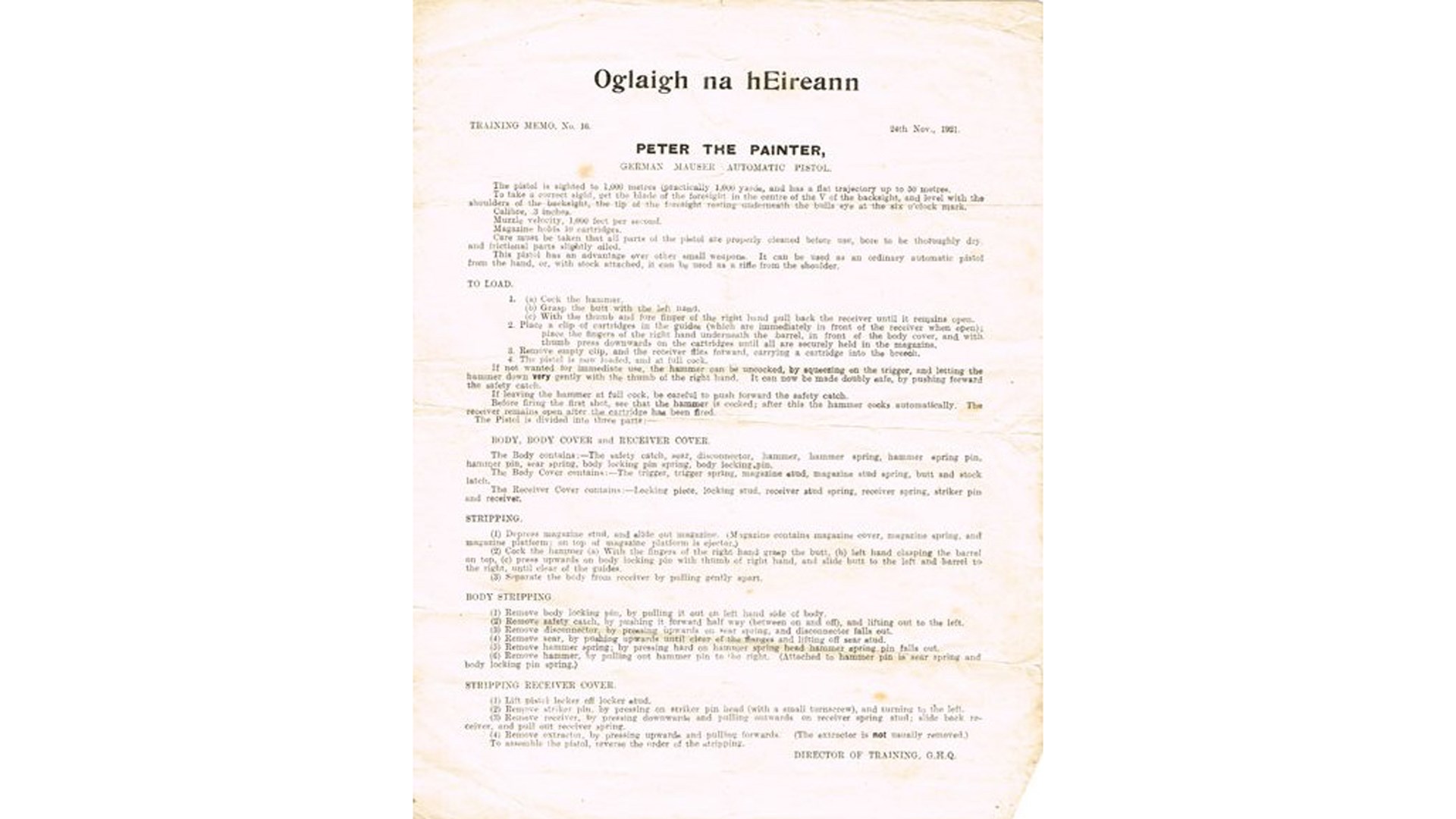 While most, if not all, of the Mauser “Broomhandles” carried in the 1916 Easter Rising were chambered in 7.63mm Mauser, the 9mm “Red Nines” most likely did not see action until the 1919-1921 Irish War of Independence. This manual for “.03-in” Painters was produced during the Truce, and before the Irish Civil War began in 1922. Image courtesy of Michael Curran.
While most, if not all, of the Mauser “Broomhandles” carried in the 1916 Easter Rising were chambered in 7.63mm Mauser, the 9mm “Red Nines” most likely did not see action until the 1919-1921 Irish War of Independence. This manual for “.03-in” Painters was produced during the Truce, and before the Irish Civil War began in 1922. Image courtesy of Michael Curran.
Just as this “Red Nine” Mauser fails to fit any classification, so it is impossible to tell the whole story of the Mauser in Ireland. Very few pistols survive from the period. Contemporary accounts are also confusing, with the terms” pistol”, “revolver”, and “automatic” being used interchangeably. The Nationalist forces probably never had more than the 160 Mausers that were on hand at the time of the June 1921 Truce. These few pistols, whether you call them “Broomhandles” or “Painters”, were essential weapons in the nation’s fight for freedom."
About a dozen or so years after this unpublished article was drafted, a trio of arms enthusiasts from Virginia bid on a lot of 270 9 mm Mauser C96 “Broomhandle” pistols, three groups of Lugers, and on other guns in an auction being held by the Irish Defense Forces (IDF) in Dublin. Anticipating a move from the Peadar Clancy Barracks (formerly the British Army’s pre-1922 Islandbridge Barracks) in Dublin to the Irish Army’s Curragh Camp in Kildare, the Irish Defense Forces’ Ordnance Corps had to dispose of obsolete surplus arms—some of which had been stored in the barracks for years and years—and they officially set up a formal auction. However the three partners were successful only in their bid on a small lot (28) of Navy Lugers, and the story of their acquisition can be found at "The Irish Lugers: An Update."
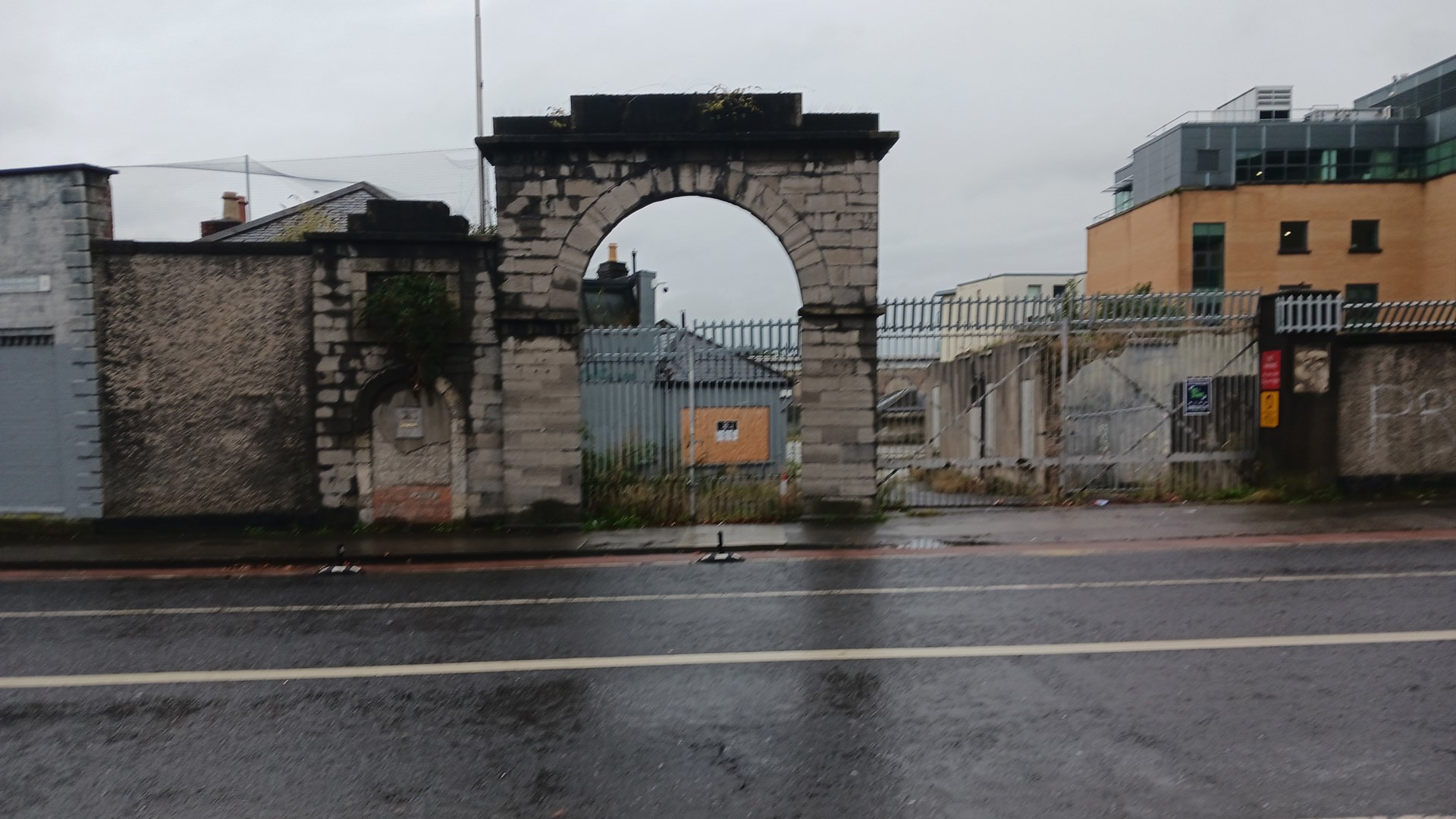 Now derelict and in disrepair, the armory yard of the former Peadar Clancy Barracks is a short stroll from the new National Museum at Collins Barracks, and is awaiting urban renewal. This is where the 1990 auction took place, and it was the source for most of the Irish ordnance that Interarms imported into the United States in 1959. Image courtesy of authors.
Now derelict and in disrepair, the armory yard of the former Peadar Clancy Barracks is a short stroll from the new National Museum at Collins Barracks, and is awaiting urban renewal. This is where the 1990 auction took place, and it was the source for most of the Irish ordnance that Interarms imported into the United States in 1959. Image courtesy of authors.
Noted author and firearms authority, William B. Edwards, led the trio and he had seen the Mauser C96 pistols and Lugers among thousands of other arms, during a visit to the barracks in 1948. Later, in the late 1950s, he accompanied the legendary Sam Cummings (the founder of International Armaments Corporations—“Interarms” or “Interarmco”) on another visit to the Clancy Barracks. Cummings subsequently purchased about 28,000 Short Magazine Lee Enfields (SMLEs), thousands of Webley revolvers, assorted “old Mausers”, and other arms, and then sold them in the United States during the 1960s and 1970s, along with a veritable shipload of Irish (formerly British) artillery and machine guns (see “Ivy Patch Gun” and “Irish Light Lewis Machine Guns in the United States”).
For reasons unknown, the semi-automatic pistols were not included in this massive 1959 sale to Cummings and Interarms, but the Irish Defense Forces later offered them to Edwards in 1969. However, the 1968 Gun Control Act (GCA) had gone into effect in the United States by that time, and further importation of surplus military arms was banned, so Edwards had to decline. In 1985, the 1968 GCA was modified to allow certain types of historical arms to be imported, so the IDF initiated a formal auction. A well-known, major surplus arms dealer was successful in bidding on the Mauser C96 pistols, and acquired all 270 of them. The pistols were sold off to American collectors in the 1990s, and all of the guns had the importer’s mark (“Century”) under the barrel. However, the company did not release any information about the source of the pistols, so collectors just assumed that they just had purchased a run-of-the-mill standard German “Red Nine” 9 mm Mauser pistol, not realizing that their pistol may have played a role in the Irish War of Independence or the Irish Civil War, or perhaps had been used by the Free State Army in the 1930s. Some of the pistols on the list have three- and four-digit serial numbers, and range up to six-digit numbers, with no discernible pattern or groupings.
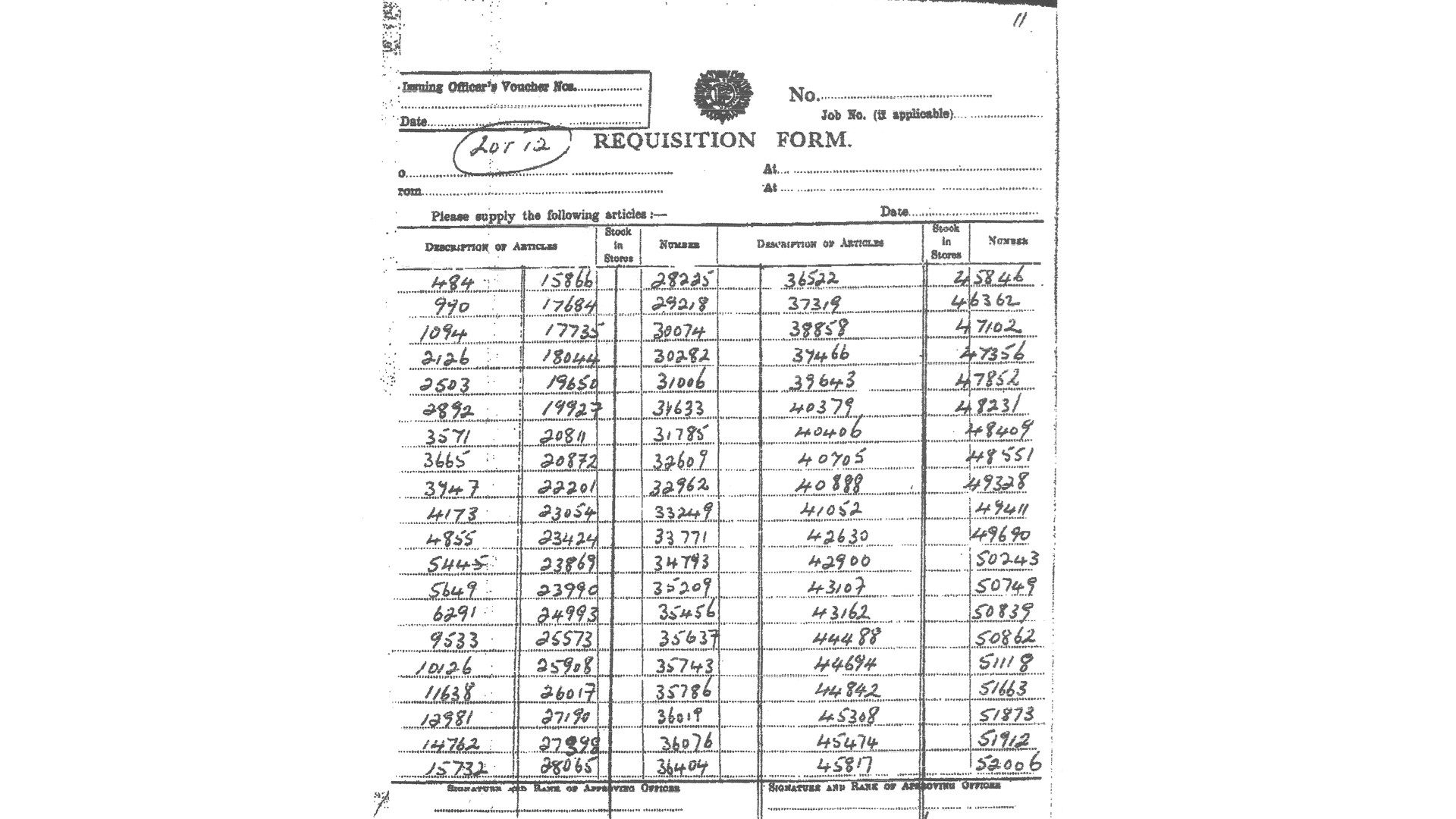 The 270 9 mm Mauser “Broomhandles” are all listed sequentially by serial number on these three documents from the Irish government. Image courtesy of authors.
The 270 9 mm Mauser “Broomhandles” are all listed sequentially by serial number on these three documents from the Irish government. Image courtesy of authors.
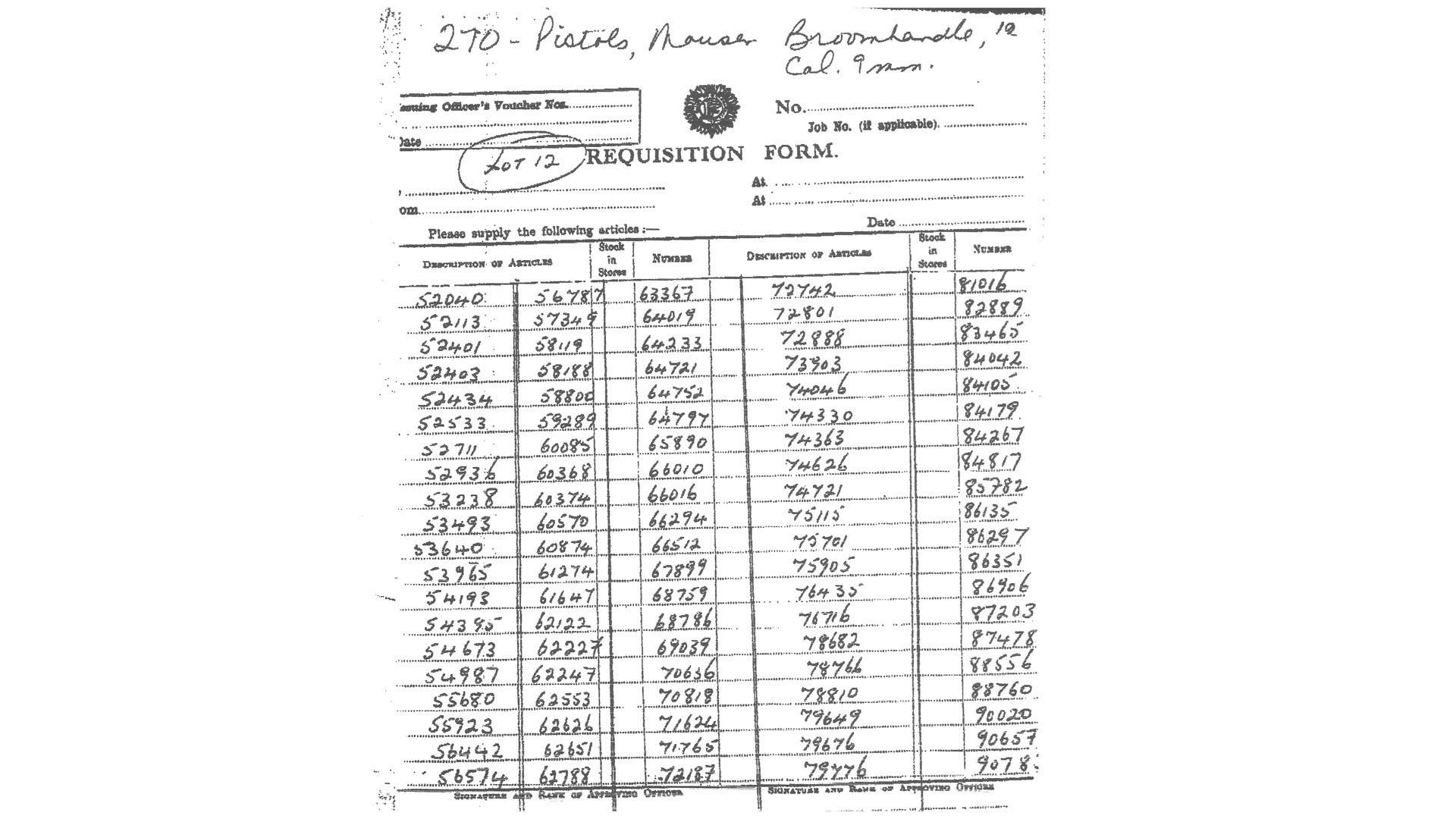
Although the serial numbers range from three- to six-digit numbers, there is no way to positively identify which guns were smuggled into Ireland between 1919 and 1923, and which ones, if any, may later have been sold to the Irish Free State by Germany in the early 1930s, if rumors prove to be correct. Image courtesy of authors.
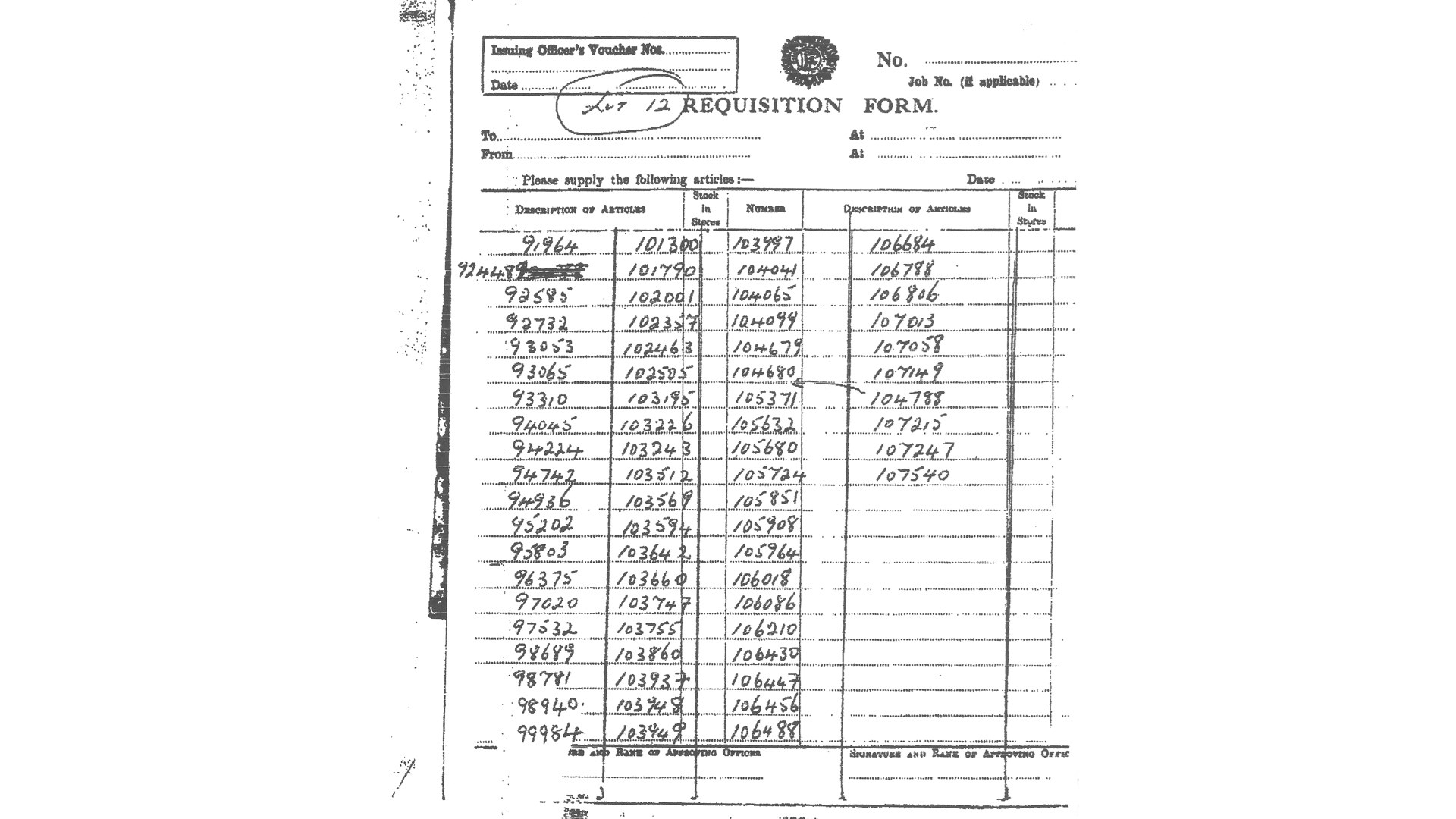
Despite the fact that at least more than half of these guns did not reach Ireland until after the 1921 Truce, they were used extensively by both sides in the 1922-1923 Irish Civil War. Image courtesy of authors.
Meanwhile, unbeknownst to everyone involved at that time, the Irish Bureau of Military History had a treasure trove of 1,773 personal accounts and memoirs from the period of the “Troubles” that had been compiled from interviews with veterans taken from the mid-1930s through the late 1950s. However, this collection was under strict governmental control, and was not available to researchers. Thankfully, the entire collection was put online in the early 21st century (see https://www.militaryarchives.ie/collections/online-collections/bureau-of-military-history-1913-1921), and it is now available to anyone wishing to research the guns used in this action-packed period of history.
Better yet, the website has a search mechanism that allows the researcher to do a “keyword” search, so all one has to do is to type in the word “Painter” (the Irish term for a C96 Mauser pistol—there are a lot of entries for "Mauser!"), and at least 110 accounts appear, with about two-thirds of them being about C96 Mauser pistols being carried, used, captured, and imported (most often smuggled) during the 1913-1923 years, and with each entry having the word “Painter” highlighted in the appropriate sentence. About one third of these entries are about house painters or artists, and can easily be discounted in a search. A search for “Mauser” turns up all sorts of entries, ranging from C96 pistols, M1871 “Howth Rifles”, souvenir or smuggled Gewehr 98 rifles, and sporting Mauser rifles being smuggled before the outbreak of the Irish Civil War, to other Mauser pistols—but mostly of rifles. Many of these tales equal, if not surpass, some of the stories that Dick Keogh recounted in his previously unpublished article.
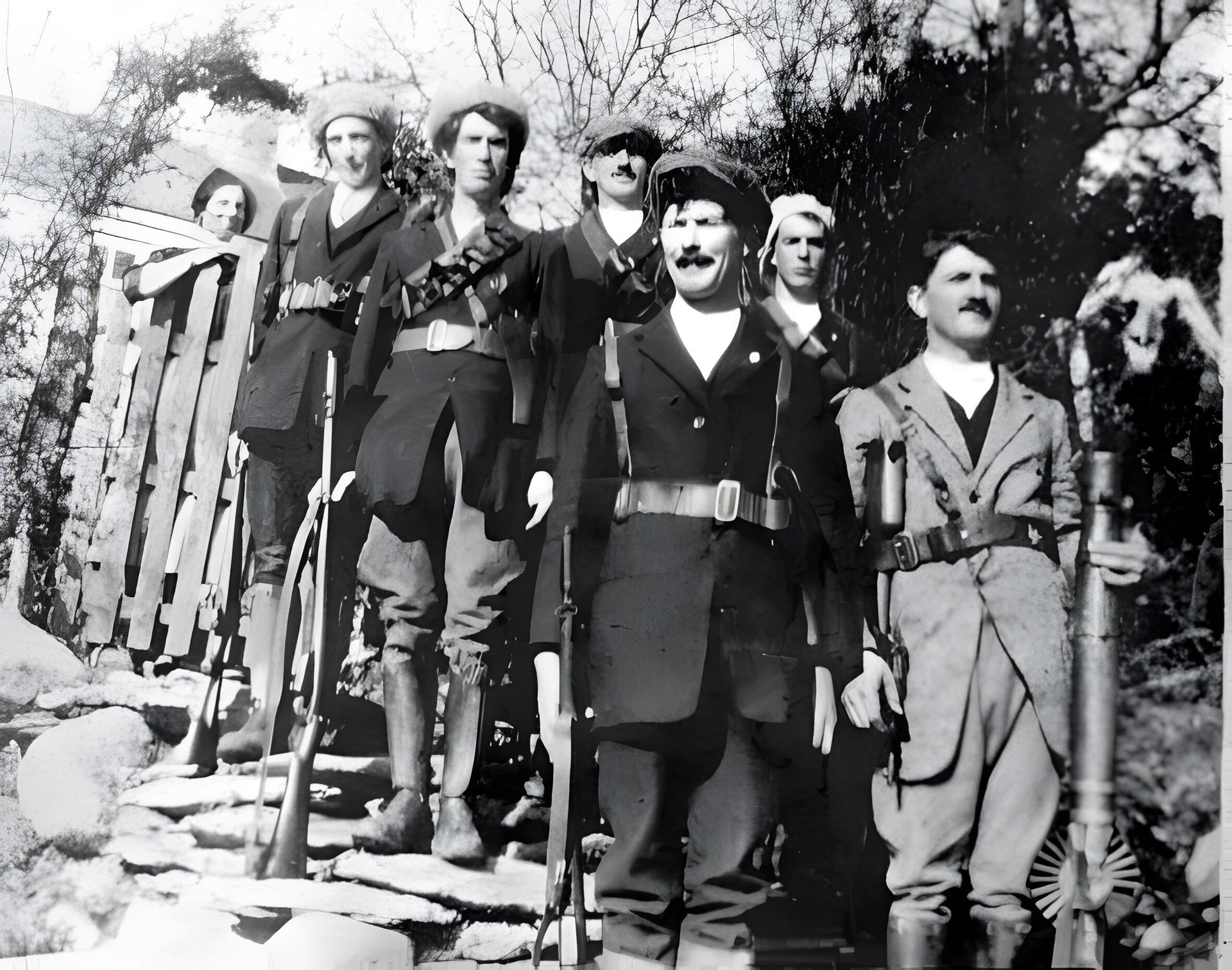 The collection of “Witness Statements” on the Irish Bureau of Military History’s website has hundreds of accounts of IRA actions, and many of them mention “Painters.” This IRA group includes an Irish Volunteer (front right) holding a captured Lewis Light Machine Gun, and with a Painter jammed in his Sam Browne belt. Image courtesy of Michael Curran.
The collection of “Witness Statements” on the Irish Bureau of Military History’s website has hundreds of accounts of IRA actions, and many of them mention “Painters.” This IRA group includes an Irish Volunteer (front right) holding a captured Lewis Light Machine Gun, and with a Painter jammed in his Sam Browne belt. Image courtesy of Michael Curran.
In his fascinating new (2021) book, Arming the Irish Revolution: Gunrunning and Arms Smuggling, 1911-1922, author Dr. William H. Kautt, lists the number of “Broomhandle” C96 Mausers (20) that the IRA acquired in the nine months before the July 1921 Truce, and it is a surprisingly lower figure than the number of Lugers (54) than one would expect, since the “Peter the Painter” (as the Mauser C96 generally was known in Ireland) is perhaps the most emblematic firearm of the Irish bid for independence. After the establishment of the Irish Free State in 1922, Ireland was still in need of semi-automatic pistols, so, as Dick Keogh mentions in his 1979 article on Lugers (see “Irish Lugers: An Update”) “rumors persist” that the Free State government imported “Red Nine” C96 Mausers in the 1930s from Germany. Perhaps some of the guns auctioned off in 1990 came into Ireland at that time? This possibility may prove to be a fascinating research project, and, in recent years, the Irish Defense Forces has opened a new archival repository that would hold these records. Equally intriguing would be the disposition of all the 7.63mm Painters that the Free State Army held at the end of the Irish Civil War. They were not among the 270 “Red Nines” auctioned off in 1990, or among the 293 “Mauser” pistols on hand with the Irish Army in 1940, so what happened to them?
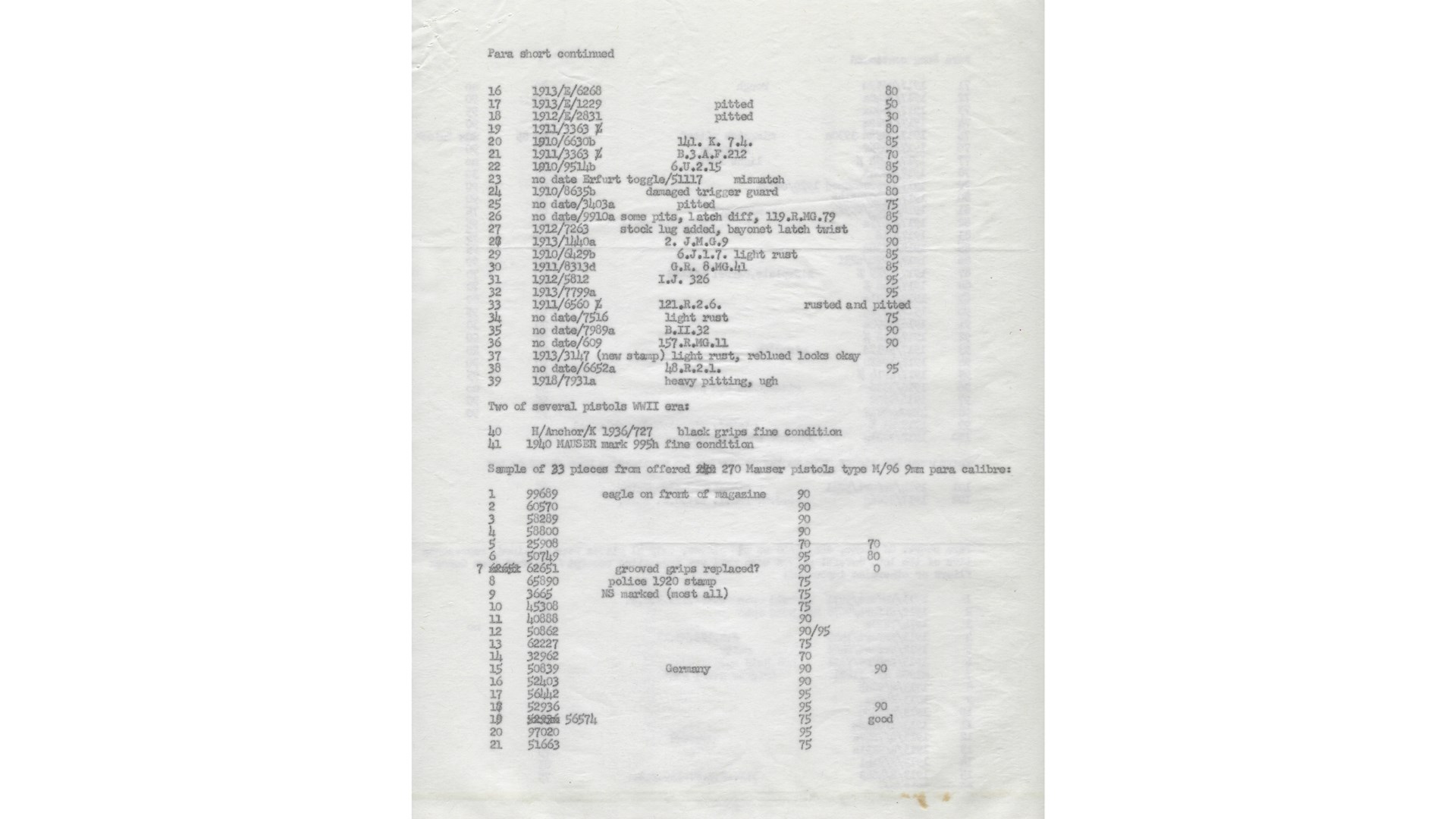
Although Edwards and his colleagues (one of whom, Charles Rausch, saved this listing they had drawn up) lost the bid on the Mausers, they successfully bid on the small lot of 28 Navy Lugers. However, someone else acquired the huge quantities of Army P1908 (240) and Artillery Lugers (100), and some of the “short” Lugers are also shown here. This purchaser has yet to be identified, but the value of these pistols certainly would be enhanced were the current owners of these guns to be made aware of their provenance. Image courtesy of Vincent Rausch.
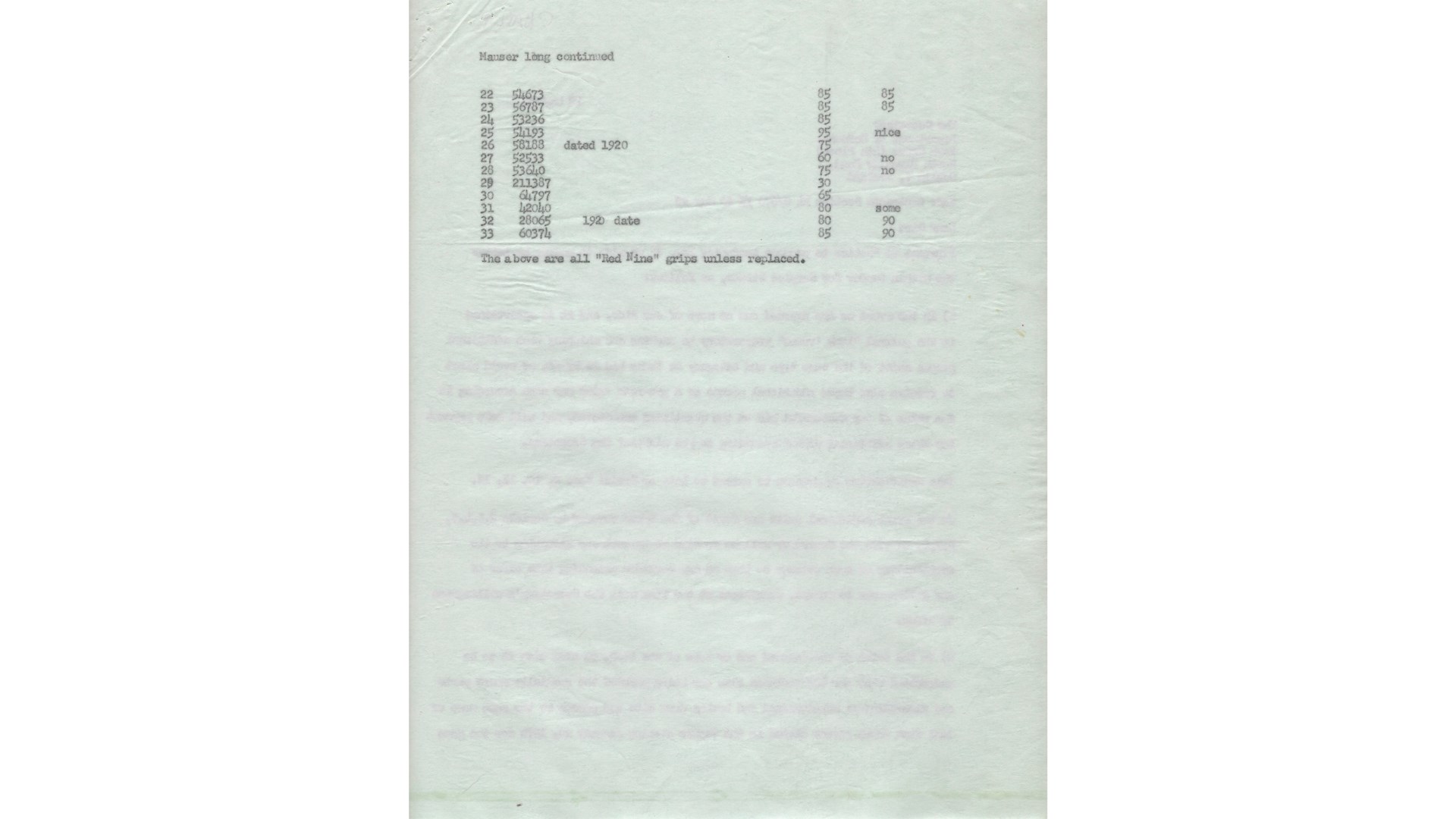
A major surplus arms dealer acquired all 270 C96 Mauser 9 mm “Broomhandle” pistols, and all of the guns are marked with the firm’s name (“Century”) under the barrel. A selection of them is listed here, on this second page of an abbreviated list (samples) drawn up by the trio from Virginia. Image courtesy of Vincent Rausch.
Today, as it is the case with most of the arms used by the Nationalists in this period (“Howth Mauser” rifles, SMLEs, Webleys, S&Ws, Lewis Guns, Lugers, etc.) the vast majority of these guns are now in the United States, with nearly all of those that remain in Ireland being in museums. The National Museum at Collins Barracks in Dublin has several noteworthy “Peter the Painters” on display, the Wicklow County Museum has a “Bolo” variation on exhibit, and the recently debuted O’Hagan collection in Belfast has at least one. There are a few others in small local museums, and in private hands. A complete, but fully demilitarized, C96, with Irish Volunteer provenance, recently sold at a well-known auction house in Dublin for 6,000 Euros.
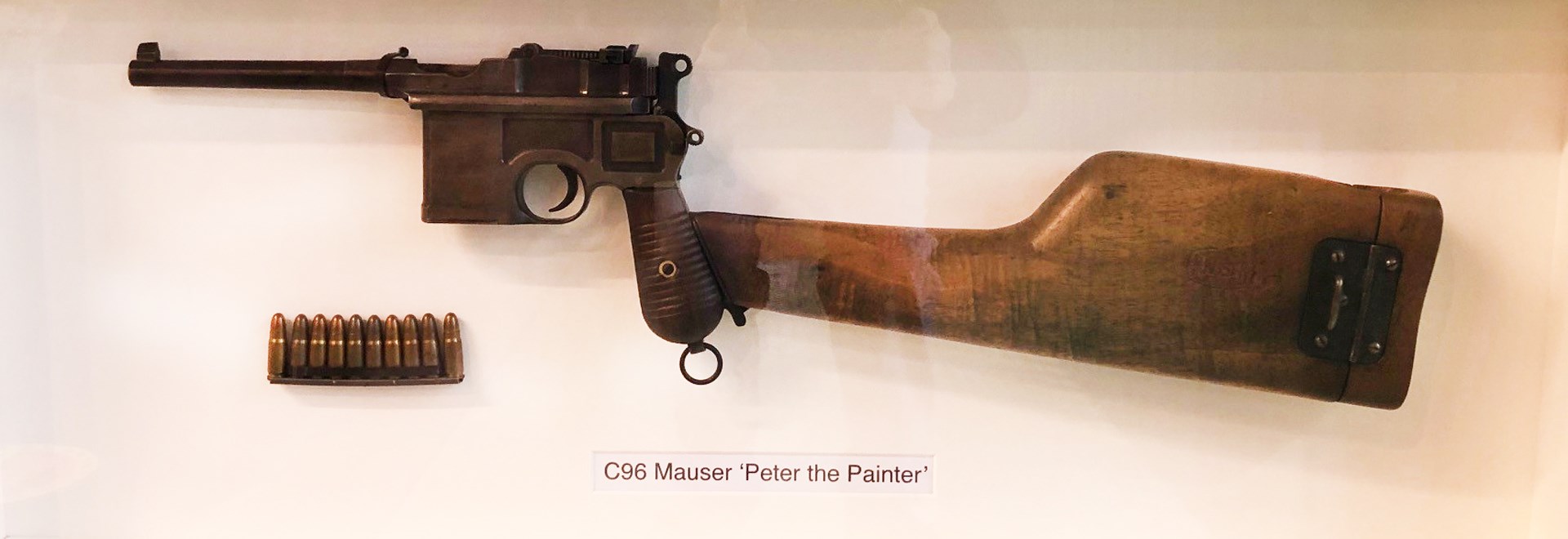 In recent years, the Pat O’Hagan collection (that, in addition to this 7.63 mm C96 Mauser, includes “Howth” Mausers, an Artillery Luger, and even a M1921 Thompson Submachine Gun!) has been displayed at several museums in Belfast. However, privately owned “Peter the Painters” are few and far between in Ireland today. Image courtesy of Michael Curran.
In recent years, the Pat O’Hagan collection (that, in addition to this 7.63 mm C96 Mauser, includes “Howth” Mausers, an Artillery Luger, and even a M1921 Thompson Submachine Gun!) has been displayed at several museums in Belfast. However, privately owned “Peter the Painters” are few and far between in Ireland today. Image courtesy of Michael Curran.
There is still much more to be learned about the role of the “Peter the Painter” Mauser in the struggle for Irish independence, and Mauser pistol collectors are urged to investigate the resources now at hand.
Ken Smith-Christmas is a frequent contributor to the American Rifleman magazine. He and Dick Keogh (a well-known firearms authority—especially on 9 mm handguns) have been good friends for more than 20 years through their mutual interest in Irish firearms. The authors thank Michael Curran, Mark A. Keefe IV, Michael J. Parker and Vincent Rausch for their assistance with this article.













